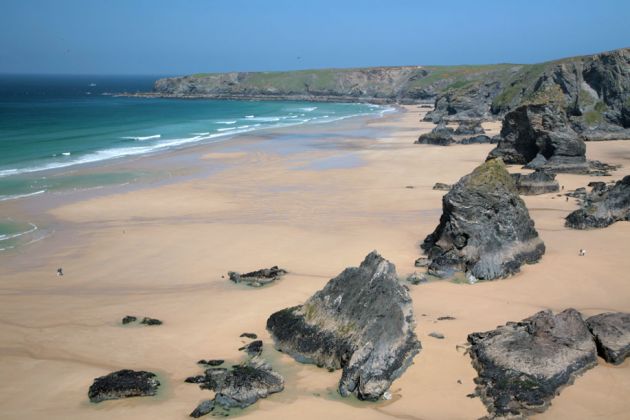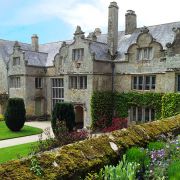Top 10 National Trust in Cornwall
By The Cornwall Guide. Last updated
Over the last 50 years or so the National Trust has built up a portfolio of many of the finest country houses and gardens in Cornwall, but this is only part of the story. In an effort to protect the natural beauty Cornwall is endowed with the National Trust now own swathes of the Cornish coast currently managing over 40% of it. The trust have also invested in the preservation of Cornwall’s industrial heritage with purchases of tin mining sites and fishing coves such as Penberth.
-
Lanhydrock House
Lanhydrock is a magnificent country house that now serves as the headquarters of the National Trust in Cornwall. There are fifty rooms to explore, from deeply elegant and spacious dining rooms and bedrooms to kitchens, nurseries and servant's quarters. The beautifully landscaped gardens, a riot of brightly-coloured azaleas and magnolias in early spring, also feature pretty native woodland and a thatched gardener's cottage with views of Bodmin moor. Events throughout the year include open-air theatre productions, garden tours and a variety of children's activities. There is a newly-opened museum and second-hand bookshop as well as a plant area and restaurant serving delicious local food. -
Cotehele House
Cotehele is a Tudor house in St Dominick, near Saltash, on the west bank of the River Tamar. The house, whose name derives from the Cornish meaning 'the wood on the estuary', is surrounded by both formal and natural gardens, ranging from well-tended flower beds to extensive woodland and including the remnants of two original deer parks and a thatched Victorian summerhouse. Miles of footpaths follow the river and criss-cross the woodland. There is a working water mill on the quay, along with tea rooms, a gallery and a museum. -
Port Quin
Port Quin is a magical near-deserted cove with a rugged natural harbour. Although calm and serene on a peaceful summer's day, Port Quin is subject to savage storms in winter. In the nineteenth century one such storm wiped out the entire fishing fleet, causing the women to abandon their homes, which fell into ruin and disrepair. Only four houses remain today, all of which are owned by the National Trust and rented out as holiday lets. There is a small car park in the cove, which can also be accessed via a very steep stretch of coast path from Port Isaac, a couple of miles away. -
Glendurgan gardens
Glendurgan is one of the best-known subtropical gardens in Cornwall, featuring bamboo, tree ferns and other exotics. At its heart is a famous laurel maze, originally planted in 1833, with a reconstructed Victorian summerhouse at its centre. The beautifully-designed garden is set in a sheltered valley that leads down to the pretty fishing village of Durgan. Regular ferries shuttle across the river to Helford. -
Bedruthan Steps
Bedruthan Steps is one of Cornwall's more dramatic beaches, named after a series of massive rock stacks supposedly placed there by a giant, called Bedruthan, for use as stepping stones. The series of rocky and dangerous beaches are accessed via a steep flight of steps from Carnewas cliffs, where there is a National Trust cafe and toilets. The beaches feature numerous fascinating nooks and crannies and link up at low tide to reveal over a mile of golden sand, although care should be taken not to get cut off as the tide comes in! -
Boscastle
Boscastle is a tiny port with a natural harbour situated on an exceptionally beautiful stretch of coastline five miles north of Tintagel. In 2004, dramatic floods caused untold damage to the tiny settlement, most of which is owned by the National Trust. Most of the Boscastle's trademark thatched and whitewashed cottages have been rescued and rebuilt, along with the Witchcraft Museum, which offers a ghoulish look at Cornwall's dark side. Boat trips depart from the harbour for Long Island, where Razorbills, Guillemots and Puffins can be spotted. -
Kynance Cove
It is easy to see why Kynance, snuggled under towering cliffs less than two miles from Lizard point, is one of the most-photographed coves in Cornwall. Sparkling turquoise water, pristine white sand, offshore stacks and islands and numerous interconnected caves to explore have ensured that Kynance has been popular since Victorian times, in spite of its relative remoteness. The National Trust have recently built a toll road and car park, making Kynance more accessible. Lifeguards patrol the beach in summer, where strong currents can make swimming dangerous. -
St Michael's Mount
St Michael's Mount is a picturesque island just off the ancient town of Marazion. Accessible by boat or via a causeway that is exposed at low tide, the mount is home to a working community of local people and a spectacular medieval castle, surrounded by stunning, exotic gardens that can be visited separately. The gardens, which were first planted in the 1780s, feature plants growing on an almost vertical rock-face that is gently warmed by the sun, providing the perfect habitat for a number of rare and delicate species. The Sail Loft restaurant offers hearty lunches and snacks. -
Levant Mine
Levant Mine is situated on the edge of the cliff five miles north of Land's End. Once famous for rich undersea deposits of copper and tin, the mine workings at Levant continued for more than a mile out underneath the Atlantic. The main engine house is home to the oldest beam engine in Cornwall, which has been fully restored and rebuilt and is once more being driven by steam. Levant is open Sunday to Friday throughout the summer and on selected days from Easter until October. -
Antony House
Antony is a tiny coastal village and parish on the Rame peninsula, three miles west of Torpoint. Antony House, a large, square edifice of Petnan stone that was built for the Carew family in 1711, lies just over a mile from the village. It is thought that Daphne DuMaurier's story 'My Cousin Rachel' was inspired by Rachel Carew, whose portrait is on display. Although the Carew family still live there, the house is now in the care of the National Trust, who open it to the public between March and October. Antony House was recently used as the film set for Walt Disney's 'Alice in Wonderland', directed by Tim Burton.















